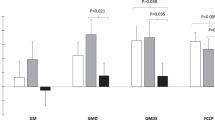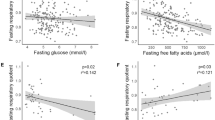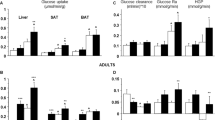Abstract
OBJECTIVE: To determine: (a) whether active pyruvate dehydrogenase (PDHa) activity in interscapular brown adipose tissue (IBAT) is acutely regulated by altered insulin status at euglycaemia; (b) the relationship between glucose uptake/phosphorylation and PDHa activities in IBAT in vivo; and (c) the impact of increased dietary lipid on the regulation of glucose uptake and oxidation by insulin in IBAT in comparison with that exerted on various white adipose tissue depots.
DESIGN: Rats were provided with either a standard diet (8% fat, 72% carbohydrate, by energy) or a diet moderately high in saturated fat (47%, by energy) and low in carbohydrate (33%, by energy) for four weeks. Rats were studied in the absorptive state, in the post-absorptive state or after 2.5 h euglycaemic hyperinsulinaemia. Tissues sampled included IBAT and four white adipose tissue depots, two abdominal (parametrial (PM) and perirenal (PR)) and two superficial (subcutaneous (SC) and interscapular (IS)).
MEASUREMENTS: Whole-body glucose disposal was estimated using [3-3H]glucose. Glucose uptake/phosphorylation in vivo was estimated using 2-deoxy[1-3H]- D-glucose. Insulin action was evaluated using the euglycaemic-hyperinsulinaemic clamp technique. PDHa activity was assayed spectrophotometrically in freeze-clamped tissue extracts. PDH kinase (PDK) activities were assayed in mitochondrial extracts by rates of ATP-dependent PDHa inactivation.
RESULTS: Whole-body glucose disposal was decreased by high-fat-feeding in the post-absorptive state (P<0.05) and during euglycaemic hyperinsulinaemia (P<0.01). Glucose transport/phosphorylation in IBAT was decreased by high-fat feeding in the absorptive (P<0.001) and post-absorptive states (by 84%, P<0.05) and during steady-state euglycaemic hyperinsulinaemia (by 73%, P<0.001). IBAT PDHa activities were suppressed by high-fat feeding. Euglycaemic hyperinsulinaemia in post-absorptive control rats increased PDHa activities in IBAT (P<0.001) to values comparable to those found in the absorptive state. Although IBAT PDHa activities were increased by euglycaemic hyperinsulinaemia in post-absorptive high-fat-fed rats, they remained lower (by 55%; P<0.01) than those of controls. The failure of hyperinsulinaemia to normalise IBAT pyruvate dehydrogenase complex (PDHC) activities in high-fat-fed rats was associated with a stable 1.4-fold increase in IBAT PDK activity. High-fat feeding decreased glucose utilisation rates in the post-absorptive state in IS, but not in SC, PM or PR white adipose tissue depots. Euglycaemic hyperinsulinaemia significantly increased glucose utilisation in three out of the four depots of the control rats, but did not elicit statistically-significant changes in high-fat-fed rats. High-fat feeding influenced PDHa activity in PR, but was without significant effect on PDHa activity in PM, SC and IS.
CONCLUSIONS: The results demonstrate that PDHa activity in the IBAT of rats maintained on standard diet responds to changes in insulin concentrations over the low physiological range, and that inactivation of PDHa in IBAT after feeding a diet moderately high in saturated fat is a consequence of the induction of tissue insulin resistance. Effects of this dietary regime on PDHa activity are paralleled by changes in insulin-stimulated glucose uptake/phosphorylation by IBAT in vivo, and IBAT is specifically targeted, with only moderate effects in white adipose tissue. The finding of impaired activation of BAT glucose transport/phosphorylation and PDHa activity in response to insulin may contribute to impaired thermogenesis in rats maintained on diets containing a relatively high proportion of saturated fat.
This is a preview of subscription content, access via your institution
Access options
Subscribe to this journal
Receive 12 print issues and online access
$259.00 per year
only $21.58 per issue
Buy this article
- Purchase on Springer Link
- Instant access to full article PDF
Prices may be subject to local taxes which are calculated during checkout
Similar content being viewed by others
Author information
Authors and Affiliations
Rights and permissions
About this article
Cite this article
Holness, M., Sugden, M. The impact of increased dietary lipid on the regulation of glucose uptake and oxidation by insulin in brown- and a range of white-adipose-tissue depots in vivo. Int J Obes 23, 629–638 (1999). https://doi.org/10.1038/sj.ijo.0800892
Received:
Revised:
Accepted:
Published:
Issue Date:
DOI: https://doi.org/10.1038/sj.ijo.0800892



